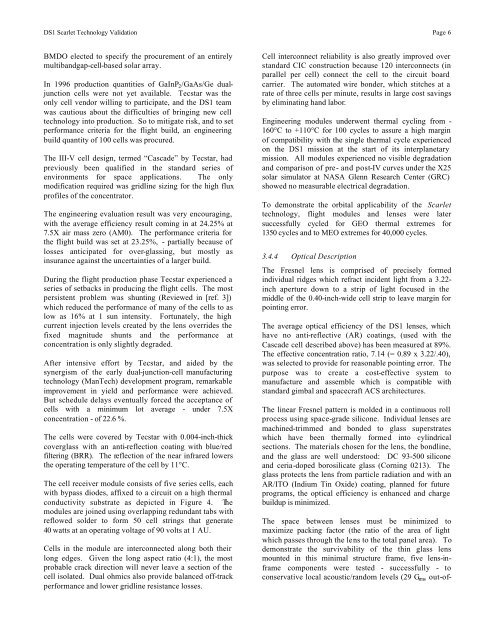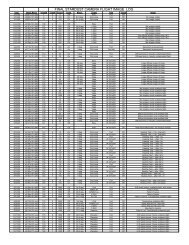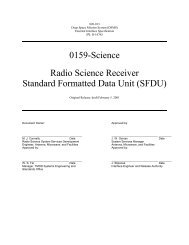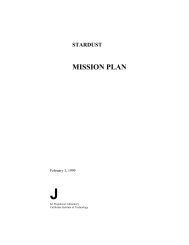The Scarlet Solar Array - PDS Small Bodies Node
The Scarlet Solar Array - PDS Small Bodies Node
The Scarlet Solar Array - PDS Small Bodies Node
- No tags were found...
Create successful ePaper yourself
Turn your PDF publications into a flip-book with our unique Google optimized e-Paper software.
DS1 <strong>Scarlet</strong> Technology Validation Page 6<br />
BMDO elected to specify the procurement of an entirely<br />
multibandgap-cell-based solar array.<br />
In 1996 production quantities of GaInP 2 /GaAs/Ge dualjunction<br />
cells were not yet available. Tecstar was the<br />
only cell vendor willing to participate, and the DS1 team<br />
was cautious about the difficulties of bringing new cell<br />
technology into production. So to mitigate risk, and to set<br />
performance criteria for the flight build, an engineering<br />
build quantity of 100 cells was procured.<br />
<strong>The</strong> III-V cell design, termed “Cascade” by Tecstar, had<br />
previously been qualified in the standard series of<br />
environments for space applications. <strong>The</strong> only<br />
modification required was gridline sizing for the high flux<br />
profiles of the concentrator.<br />
<strong>The</strong> engineering evaluation result was very encouraging,<br />
with the average efficiency result coming in at 24.25% at<br />
7.5X air mass zero (AM0). <strong>The</strong> performance criteria for<br />
the flight build was set at 23.25%, - partially because of<br />
losses anticipated for over-glassing, but mostly as<br />
insurance against the uncertainties of a larger build.<br />
During the flight production phase Tecstar experienced a<br />
series of setbacks in producing the flight cells. <strong>The</strong> most<br />
persistent problem was shunting (Reviewed in [ref. 3])<br />
which reduced the performance of many of the cells to as<br />
low as 16% at 1 sun intensity. Fortunately, the high<br />
current injection levels created by the lens overrides the<br />
fixed magnitude shunts and the performance at<br />
concentration is only slightly degraded.<br />
After intensive effort by Tecstar, and aided by the<br />
synergism of the early dual-junction-cell manufacturing<br />
technology (ManTech) development program, remarkable<br />
improvement in yield and performance were achieved.<br />
But schedule delays eventually forced the acceptance of<br />
cells with a minimum lot average - under 7.5X<br />
concentration - of 22.6 %.<br />
<strong>The</strong> cells were covered by Tecstar with 0.004-inch-thick<br />
coverglass with an anti-reflection coating with blue/red<br />
filtering (BRR). <strong>The</strong> reflection of the near infrared lowers<br />
the operating temperature of the cell by 11°C.<br />
<strong>The</strong> cell receiver module consists of five series cells, each<br />
with bypass diodes, affixed to a circuit on a high thermal<br />
conductivity substrate as depicted in Figure 4. <strong>The</strong><br />
modules are joined using overlapping redundant tabs with<br />
reflowed solder to form 50 cell strings that generate<br />
40 watts at an operating voltage of 90 volts at 1 AU.<br />
Cells in the module are interconnected along both their<br />
long edges. Given the long aspect ratio (4:1), the most<br />
probable crack direction will never leave a section of the<br />
cell isolated. Dual ohmics also provide balanced off-track<br />
performance and lower gridline resistance losses.<br />
Cell interconnect reliability is also greatly improved over<br />
standard CIC construction because 120 interconnects (in<br />
parallel per cell) connect the cell to the circuit board<br />
carrier. <strong>The</strong> automated wire bonder, which stitches at a<br />
rate of three cells per minute, results in large cost savings<br />
by eliminating hand labor.<br />
Engineering modules underwent thermal cycling from -<br />
160°C to +110°C for 100 cycles to assure a high margin<br />
of compatibility with the single thermal cycle experienced<br />
on the DS1 mission at the start of its interplanetary<br />
mission. All modules experienced no visible degradation<br />
and comparison of pre- and post-IV curves under the X25<br />
solar simulator at NASA Glenn Research Center (GRC)<br />
showed no measurable electrical degradation.<br />
To demonstrate the orbital applicability of the <strong>Scarlet</strong><br />
technology, flight modules and lenses were later<br />
successfully cycled for GEO thermal extremes for<br />
1350 cycles and to MEO extremes for 40,000 cycles.<br />
3.4.4 Optical Description<br />
<strong>The</strong> Fresnel lens is comprised of precisely formed<br />
individual ridges which refract incident light from a 3.22-<br />
inch aperture down to a strip of light focused in the<br />
middle of the 0.40-inch-wide cell strip to leave margin for<br />
pointing error.<br />
<strong>The</strong> average optical efficiency of the DS1 lenses, which<br />
have no anti-reflective (AR) coatings, (used with the<br />
Cascade cell described above) has been measured at 89%.<br />
<strong>The</strong> effective concentration ratio, 7.14 (= 0.89 x 3.22/.40),<br />
was selected to provide for reasonable pointing error. <strong>The</strong><br />
purpose was to create a cost-effective system to<br />
manufacture and assemble which is compatible with<br />
standard gimbal and spacecraft ACS architectures.<br />
<strong>The</strong> linear Fresnel pattern is molded in a continuous roll<br />
process using space-grade silicone. Individual lenses are<br />
machined-trimmed and bonded to glass superstrates<br />
which have been thermally formed into cylindrical<br />
sections. <strong>The</strong> materials chosen for the lens, the bondline,<br />
and the glass are well understood: DC 93-500 silicone<br />
and ceria-doped borosilicate glass (Corning 0213). <strong>The</strong><br />
glass protects the lens from particle radiation and with an<br />
AR/ITO (Indium Tin Oxide) coating, planned for future<br />
programs, the optical efficiency is enhanced and charge<br />
buildup is minimized.<br />
<strong>The</strong> space between lenses must be minimized to<br />
maximize packing factor (the ratio of the area of light<br />
which passes through the lens to the total panel area). To<br />
demonstrate the survivability of the thin glass lens<br />
mounted in this minimal structure frame, five lens-inframe<br />
components were tested - successfully - to<br />
conservative local acoustic/random levels (29 G rms out-of-






